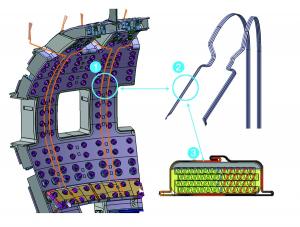European agency signs long-term collaboration in diagnostics
21 Mar 2012
-
Samina Shamsie, Fusion for Energy
Diagnostic sensors are located within the interior and the exterior of the vacuum vessel. Shown here: conduits (1), cable looms (2), and a conduit cross-section (3) where cable looms and filler material (in yellow) are visible.
The European Domestic Agency has signed its first Framework Partnership Agreement (FPA) for the design of diagnostic components. Amounting to EUR 3.7 million, and covering a period of up to four years, the FPA has been awarded to a consortium consisting of three laboratories from the Hungarian fusion association: Wigner RCP (formerly KFKI RMKI); MTA EK (formerly KFKI AEKI); and the Budapest University of Technology and Economics.
The agreement concerns the infrastructure (cabling, conduits, feedthroughs, connectors) for the diagnostic systems and covers R&D, engineering, quality control and testing from functional specifications. This is an important step in the drive for First Plasma, as many of these components must be installed during the first stage of ITER assembly.
So what exactly is a Framework Partnership Agreement? It establishes a long-term collaboration (for up to four years) with a beneficiary or consortium. The Agreement defines a set of rules for the accomplishment of the work; with the work itself performed under separate, specific grant agreements.
The FPA is well-fitted to projects requiring mostly R&D and early design. It is ideal for diagnostics, where designs are usually 'first-of-a-kind' and require a large, specialized design base the continuity of the design team.
A further advantage of the FPA is that it enables the European Domestic Agency (F4E) to have a stronger project management role.
This first FPA will bring together the work of some 30 people per year. F4E is expecting to award FPAs for most of the major diagnostic systems under its responsibility during 2012.


